

Cartier
Nouveautés 2012 des montres Cartier
Cartier ID Two
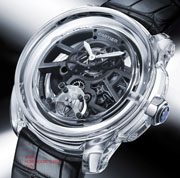 Le chiffre est stupéfiant : à l’intérieur d’un mouvement de montre, 75% de l’énergie sont gaspillés en frottements divers et résistance à l’air. Au coeur d’un boîtier pourtant étanche, chaque composant en mouvement, aussi petit soit-il, subit une pression aérodynamique qui freine ses évolutions.
Le chiffre est stupéfiant : à l’intérieur d’un mouvement de montre, 75% de l’énergie sont gaspillés en frottements divers et résistance à l’air. Au coeur d’un boîtier pourtant étanche, chaque composant en mouvement, aussi petit soit-il, subit une pression aérodynamique qui freine ses évolutions.
Après avoir réfléchi aux possibilités techniques d’amélioration des coefficients de pénétration dans l’air, les équipes du laboratoire de recherche et développement de la Manufacture ont eu une idée choc : « Et si, au lieu de chercher à diminuer les conséquences de la pression aérodynamique, on supprimait la cause ? » En clair : supprimer l’air !
Malgré son extrême simplicité apparente, cette solution révolutionnaire a entraîné des difficultés techniques tout aussi extrêmes. Pour limiter les risques de “ fuites ”, les ingénieurs ont dû concevoir un boîtier en deux parties seulement, dépourvues de la moindre vis. Les joints placés entre le boîtier monobloc et le fond, ainsi qu’autour de la couronne de réglage, ont quant à eux été rendus encore plus étanches grâce à l’adjonction de nanoparticules.
Au coeur de Cartier ID Two, le mouvement bat en liberté à l’intérieur d’un boîtier en céramique dont la transparence parfaite traduit le vide absolu qu’elle abrite. Et en absence de toute résistance aérodynamique, il peut développer une énergie bien supérieure aux montres traditionnelles...
Si Cartier ID Two est une concept watch qui restera une montre unique, elle met en lumière de nouvelles perspectives technologiques dont l’aboutissement, demain, permettra d’ouvrir la voie de la miniaturisation, de fonctions inenvisageables jusqu’à présent et d’un niveau de performances encore jamais atteint.
6 révolutions pour ID Two
Pour préserver l’oscillateur de la résistance de l’air lors de ses battements, le vide règne à l’intérieur du boîtier/glace monobloc en céramique transparente CeramystTM. L’étanchéité à l’air est renforcée par l’utilisation de joints dopés aux nanoparticules.
Pour la première fois dans l’histoire de l’horlogerie, les ressorts fournissant l’énergie au mouvement de la montre sont réalisés, non plus en métal, mais en microfibre de verre, augmentant considérablement la puissance délivrée.
+30% d’énergie emmagasinée grâce au barillet à double ressort en fibre de verre.
32 jours de réserve de marche dans un encombrement comparable.
La technologie DRIE (Deep Reactive Ion Etching) permet de fabriquer des composants micromécaniques avec une extrême précision (au micron près) et s’applique particulièrement bien au cristal de carbone.
Le train de rouage à différentiel en composants ultra-légers fonctionne sans lubrification, minimise les frottements et présente un rapport de réduction optimisé
Cartier ID Two reprend la solution explorée par Cartier ID One : composants fabriqués selon les technologies DRIE, oscillateur et porte-échappement en cristal de carbone, axes de pivot en titane à revêtement noir ADLC.
Mélange de carbone et d’hydrogène, le revêtement ADLC (Amorphous Diamond Like Carbone) recouvre les composants d’une fine couche noire de protection insensible à l’usure, autolubrifiante et extrêmement résistante aux chocs. Une technique utilisée dans l’aérospatiale et l’armement.
Inside a watch case a mind-boggling 75% of the energy is wasted through various friction and from air resistance. The case may be airtight but inside it each moving part, however small, undergoes aerodynamic pressure which dampens its movement.
After examining the technical possibilities for improving the air penetration coefficients, the team at the Manufacture’s research and development laboratory had a brainwave: “What if, instead of trying to mitigate the consequences of aerodynamic pressure, we removed the cause ?” In other words : getting rid of the air ! Despite its apparent extreme simplicity, this revolutionary solution brought with it some equally extreme technical difficulties.
To avoid the risk of leaks, the engineers had to design a case in just two parts, without any screws whatsoever. The seals between the case block and the back as well as those surrounding the setting crown have been made more airtight by the addition of nanoparticles.
At the heart of Cartier ID Two, the movement beats freely inside a ceramic case whose perfect transparency reflects the absolute vacuum it houses. And in the absence of all aerodynamic resistance, it can develop considerably more energy than traditional watches.
While Cartier ID Two is a concept watch that will remain a unique piece, it highlights new technological prospects that tomorrow will culminate in opening up possibilities of miniaturization, of functions unthinkable up till now and levels of performance never before achieved.
6 révolutions for ID Two
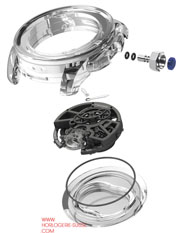 To shield the oscillator from air resistance as it beats, the interior of the single-block case/glass in Ceramyst™ transparent ceramic is a vacuum. Airtightness is reinforced by using gaskets doped with nanoparticles.
To shield the oscillator from air resistance as it beats, the interior of the single-block case/glass in Ceramyst™ transparent ceramic is a vacuum. Airtightness is reinforced by using gaskets doped with nanoparticles.
For the first time in watchmaking history, the springs providing energy to the watch movement have been made not in metal, but in glass microfiber, giving a considerable increase in power.
+30% energy stored, using a barrel with double spring in fiberglass.
32 days of power reserve in the same volume.
DRIE technology (Deep Reactive Ion Etching) allows micromechanical components to be made with extreme precision (to the nearest micron) and lends itself particularly well to carbon crystal
The differential gear train with ultra-light components works without lubrication, minimizes friction and offers an optimized reduction ratio.
Cartier ID Two reuses the solution explored in Cartier ID One: components made using DRIE technologies, oscillator and escapement bearing in carbon crystal, and pivot axes in black ADLC- coated titanium.
A mix of carbon and hydrogen, the ADLC coating (Amorphous Diamond Like Carbon) covers the components with a fine black protective layer unaffected by wear, self-lubricating, and highly shock-resistant. A technique used in aerospace and armament.
Astrotourbillon Cristal de Carbone
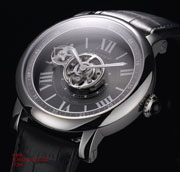 Si des montres concepts comme Cartier ID One et Cartier ID Two ne sont pas destinées à être commercialisées malgré des années de recherche et tous les investissements consentis pour leur réalisation, leur rôle est d’exprimer une vision du futur et d’indiquer des directions à suivre pour l’avenir.
Si des montres concepts comme Cartier ID One et Cartier ID Two ne sont pas destinées à être commercialisées malgré des années de recherche et tous les investissements consentis pour leur réalisation, leur rôle est d’exprimer une vision du futur et d’indiquer des directions à suivre pour l’avenir.
Chacune des innovations qu’elles contiennent est susceptible de devenir, un jour, une réalité. C’est ainsi que la nouvelle montre Astrotourbillon Cristal de Carbone reprend certaines solutions technologiques expérimentées par Cartier ID One : boîtier en niobium-titane, éléments en cristal de carbone, ancre et roue d’échappement sans réglage et sans lubrification… De la concept watch unique à la série, l’innovation Cartier fait avancer l’horlogerie tout en cultivant les valeurs esthétiques de la haute horlogerie. Ainsi, Cartier a totalement repensé le concept du tourbillon et imaginé une cage possédant un axe de rotation se situant au centre du mouvement. Effectuant un tour en une minute sur toute la surface du cadran, le pont de balancier, excentré et dessiné en forme de flèche, permet ainsi de lire les secondes.
Concept watches such as Cartier ID One and Cartier ID Two were never meant to be marketed, despite the years of research and all the investment that went into making them. Their role is to express a vision of the future and point the way to future goals.
Each of the innovations they contain may one day become a reality. And Cartier’s new Astrotourbillon Carbon Crystal watch, presented in July 2012, uses some of the technological solutions tried and tested in Cartier ID One: the niobium-titanium case, carbon crystal components, and the adjustment-free and lubrication-free pallet and escapement wheel. From the one-off concept-watch to the production run, Cartier innovation pushes back the boundaries of watchmaking while cultivating the esthetic values of Fine Watchmaking.
Cartier has totally rethought the concept of the tourbillon and come up with a carriage with its axis of rotation at the center of the movement. The off-center balance wheel bridge is designed as an arrow and turns once round the dial every minute, pointing out the seconds.
Montre Rotonde de Cartier Quantième Annuel calibre 9908 MC
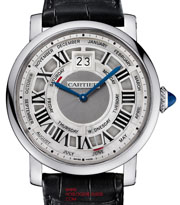 Cartier a choisi pour la montre Rotonde de Cartier Quantième Annuel de faire appel à un mécanisme de quantième annuel directement intégré à la platine du calibre 1904 MC. Cette solution, particulièrement appréciée des amateurs de belle horlogerie, a fait l’objet de nombreuses études pour permettre l’affichage de la grande date à deux chiffres indépendants à 12 heures et le réglage rapide en cascade par la couronne de remontoir des différentes indications du calendrier annuel.
Cartier a choisi pour la montre Rotonde de Cartier Quantième Annuel de faire appel à un mécanisme de quantième annuel directement intégré à la platine du calibre 1904 MC. Cette solution, particulièrement appréciée des amateurs de belle horlogerie, a fait l’objet de nombreuses études pour permettre l’affichage de la grande date à deux chiffres indépendants à 12 heures et le réglage rapide en cascade par la couronne de remontoir des différentes indications du calendrier annuel.
Original, ce mouvement épuré, développé à l’interne, dispose de plusieurs particularités significatives dont un mécanisme semi-instantané de passage de grande date à deux chiffres indépendants (passage en une heure) pour garantir à ce coeur de haute horlogerie une stabilité chronométrique optimale.
Dans cette construction, ce sont les ergots portés par le grand disque des unités qui font tourner l’étoile à quatre branches des dizaines. Ce même disque des unités -véritable coeur du système de calendrier-, possède également un autre secret : celui d’emporter un dispositif simple et intelligent permettant, grâce à une came de mémoire des mois intégrée à même la serge allégée des unités du dateur, de faire s’afficher sans erreur possible ceux de 30 ou de 31 jours une fois réglé le mois en cours.
Cette mécanique est imparable d’efficacité et programmée pour tenir compte de la longueur des mois pairs et impairs sauf pour le mois de février (28 ou 29 jours une fois tous les 4 ans), elle est strictement désindexable même en cas de gros choc.
Boîtier diamètre : 45 mm
For the Rotonde de Cartier Annual Calendar model, Cartier has chosen to incorporate an annual calendar mechanism directly into the plate of the 1904 MC calibre. This solution, particularly appreciated by lovers of fine watchmaking, was arrived at thanks to numerous tests to allow for the large date display with two independent numerals at 12 o’clock and the rapid setting of the different displays of the annual calendar through a cascade control process operated by the winding crown.
This refined movement, highly original and developed entirely in-house, incorporates a number of important features, including a semi-instantaneous mechanism for converting the large date into two independent numerals (over a one-hour conversion period) so as to ensure the maximum chronometric stability for this paragon of fine watchmaking. In this system, the four-branched star-wheel corresponding to the tens column is turned by the catches located on the large unit disc.
This unit disc – at the very heart of the calendar system – also holds another secret: it carries within it a simple and intelligent mechanism which, thanks to a cam bearing a memory of the months incorporated directly into the lightened rims of the units of the date device, makes it possible to display without any possibility of error the months having 30 or 31 days, once the current month has been set.
This mechanism of irreproachable efficiency is programmed to take into consideration the length of the months with an even or odd number of days, except in the case of February (with 28 days, or 29 once every four years). It is completely incapable of being de-indexed even if subjected to a severe impact.
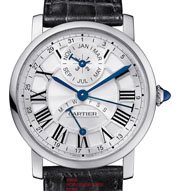 Montre Rotonde de Cartier Quantième Perpétuel calibre 9422 MC
Montre Rotonde de Cartier Quantième Perpétuel calibre 9422 MC
Mouvement mécanique manufacture à remontage automatique, calibre 9422 MC, quantième perpétuel avec indication des jours par une aiguille rétrograde, indication du mois et de l’année bissextile dans un compteur à 12 h
Movement: Manufacture self-winding mechanical, calibre 9422 MC, perpetual calendar with days indicated by retrograde hand, month and leap year by a counter at 12 o’clock
Montre Rotonde de Cartier Répétition Minutes Tourbillon Volant calibre 9402 MC
Pour obtenir un développement harmonieux de l’onde acoustique, il faut qu’il existe une liaison très forte entre la pièce émettrice de l’onde sonore et les éléments censés la diffuser. Aujourd’hui, la Maison Cartier propose une nouvelle conception horlogère qui consiste à solidariser le timbre à la platine et la platine à la carrure en quatre points. Et pour optimiser cette liaison, le talon des deux timbres de la répétition minutes est finalement vissé, chacun en un point à l’intérieur de la boîte.
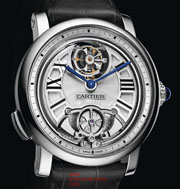 La synergie parfaite entre la boîte et le mouvement favorise la transmission des vibrations. Harmonieusement diffusées par les timbres de forme carrée, pour permettre au marteau de frapper régulièrement au même endroit malgré le fait que la lame du timbre soit rentrée en vibration, les ondes acoustiques se diffusent à travers une large surface émissive. Seulement il est essentiel que ces sons harmonieux, qui se répandent dans l’air, soient joués de façon régulière afin de pouvoir être convenablement interprétés et surtout comptés par le cerveau.
La synergie parfaite entre la boîte et le mouvement favorise la transmission des vibrations. Harmonieusement diffusées par les timbres de forme carrée, pour permettre au marteau de frapper régulièrement au même endroit malgré le fait que la lame du timbre soit rentrée en vibration, les ondes acoustiques se diffusent à travers une large surface émissive. Seulement il est essentiel que ces sons harmonieux, qui se répandent dans l’air, soient joués de façon régulière afin de pouvoir être convenablement interprétés et surtout comptés par le cerveau.
Pour obtenir une frappe constante des marteaux, la montre Rotonde de Cartier Répétition Minutes Tourbillon Volant est équipée d’un mécanisme appelé régulateur de vitesse à inertie et à frottement, particulièrement sophistiqué et silencieux. Objectivement efficace, cet organe visible grâce à une ouverture pratiquée dans le cadran ajouré, argenté galvanique de couleur ardoise, dans le prolongement de l’échappement à tourbillon volant placé à 12 heures, rentre en rotation pour réguler la vitesse de dévidement du train de rouage de la répétition minutes et du même coup obtenir une émission régulière des notes émises par les deux timbres de la montre. Ainsi l’oreille se laisse bercer au son d’une mélodie donnant l’heure tandis que le regard se laisse, dans le même temps, captiver par la folle ronde de ces deux mécanismes d’une grande complexité.
Dans cette dualité, l’un a la charge insigne de réguler l’écoulement du temps au rythme d’un tour par minute et de 21 600 vibrations par heure pour le balancier quand l’autre se doit de tempérer la mesure du jeu musical en freinant le dévidement du ressort contenu dans le barillet du mécanisme de répétition minutes manuellement réarmé à l’aide du poussoir intégré dans la carrure à 8 heures. Le choix d’un poussoir pour remplacer la traditionnelle targette, habituellement observée sur le flanc des boîtiers de répétition minutes, répond à la volonté de diminuer le rapport masse boîte / masse timbre qui détermine la puissance de vibrations. Plus petit et surtout concentré en un point de la boîte, le poussoir permet ainsi d’alléger significativement la masse de la boîte.
Cette pièce de 45 mm de diamètre est disponible en titane ou en or rose, mouvement 9402 MC constitué de 447 composants et 47 rubis, orné du poinçon de Genève.
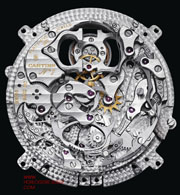 To ensure the harmonious transmission of an acoustic wave, there needs to be a very strong link between the part emitting the sound wave and the parts intended to receive it. Today Cartier proposes a new watchmaking concept that consists of linking the gong to the plate and linking the plate to the middle of the case at four points. To optimise this link, the heels of the two gongs of the minute repeater are finally screwed down, each at a particular point inside the case.
To ensure the harmonious transmission of an acoustic wave, there needs to be a very strong link between the part emitting the sound wave and the parts intended to receive it. Today Cartier proposes a new watchmaking concept that consists of linking the gong to the plate and linking the plate to the middle of the case at four points. To optimise this link, the heels of the two gongs of the minute repeater are finally screwed down, each at a particular point inside the case.
The perfect synergy between the case and the movement thus aids the transmission of the vibrations. Since square gongs allow the hammer to strike regularly at the same place despite the fact that the blade of the gong has started to vibrate, the acoustic waves are thus harmoniously diffused throughout a wide emitting surface. It is however essential that these harmonious sounds transmitted through the air be struck in a regular way so that they can be both appropriately interpreted and specifically counted by the brain. To produce the constant striking of the hammers, the Rotonde de Cartier Minute Repeater Flying Tourbillon watch is equipped with a mechanism known as an “inertia and friction governor”, which is particularly silent and sophisticated. Thanks to an aperture in the open-work dial, this objectively very efficient organ is visible with its slate-coloured galvanised silver-plating in the extension of the flying tourbillon escapement positioned at 12 o’clock. It enters into rotation so as to control the speed of the winding of the minute repeater’s strike-train and at the same time ensure the regular emission of the notes sent out by the watch’s two gongs. In this way the ear is enchanted by the tune marking the hour while at the same time the eye is captivated by the frantic whirling of these two extremely complex mechanisms.
In this dual action, one mechanism has the illustrious task of regulating the passage of time at a rate of one revolution per minute and 21,600 vibrations per hour for the balance. The other dedicates itself to moderating the rhythm of the music by controlling the winding of the spring contained in the barrel of the minute repeater mechanism manually reloaded by means of a push-piece incorporated into the case middle at 8 o’clock. The choice of a push-piece to replace the traditional bolt that is habitually observed on the side of minute repeater watch cases, answers the need to reduce the case mass / gong mass ratio that determines the power of the vibrations. Being smaller and, in particular, being concentrated at one specific point on the case, the push-piece thus enables the mass of the case to be significantly reduced.
Montre de Poche Grande Complication Squelette calibre
Tout en équilibre, cette montre à porter dans la poche révèle son potentiel attractif grâce à ses généreux 59,2 mm de diamètre. Charnue dans le creux de la main, cette pure merveille possède des proportions qui font écho aux pièces exceptionnelles créées par Cartier pour certains de ses clients privilégiés de la fin du XIXe siècle. Ce volume d’exception permet la mise en valeur d’un majestueux calibre inséré dans le rayonnement aérien des chiffres romains ajourés et ciselés dans la masse du boîtier en or gris. Une prouesse de technique qui fait oublier que, pour dégager ces douze chiffres romains du bloc d’or massif de ses origines, il a fallu pas moins de 100 heures d’un travail d’une très grande précision, consacrées à la finition et à la décoration 3 Salon International de la Haute Horlogerie – Geneva, 16-20 January 2012 de chaque chiffre. Une épreuve de patience et d’exigence, lorsque l’on sait que l’on compte 300 angles rentrants, anglés à la main…
Avec cette oeuvre faisant la part belle à la transparence, ils ont tout mis en oeuvre pour révéler quelques-uns des secrets de ce coeur mécanique à remontage manuel régulé par un tourbillon aérien et paré de deux utiles complications parmi les plus recherchées des amateurs. On notera donc qu’en plus d’afficher l’heure avec précision grâce à son tourbillon classique soutenu par un pont reprenant la forme du « C » de Cartier, cette merveille se dote d’un mécanisme de chronographe monopoussoir. Cette fonction de mesure des temps courts est enclenchée, arrêtée puis remise à zéro par le truchement d’un poussoir intégré à la couronne de remontoir ornée d’un saphir cabochon. Ce mouvement comporte également la complication de quantième perpétuel
With its well-balanced features, this watch designed for carrying in one’s pocket gives a first intimation of its force of attraction in its generous diameter measuring 59.2 mm. Solidly installed in the hollow of one’s hand, the proportions of this marvel of fine watchmaking echo those of the exceptional timepieces created by Cartier for some of its most illustrious clients in the late 19th century. These exceptional dimensions give pride of place to its magnificent calibre inserted amid the delicate display of open-work Roman numerals cut away and carefully fashioned from the solid white gold of the watch’s case. It should be noted that, in order to carve these twelve Roman numerals out of the original solid gold surface, this technical tour de force required at least 100 hours of extremely high-precision craftsmanship to perfect the finish and embellishment of each numeral. 3 Salon International de la Haute Horlogerie – Geneva, 16-20 January 2012 This constitutes a true test of patience and application, if it is considered that over 300 reflex angles are involved, with each one fashioned by hand!
With this timepiece in which transparency takes pride of place, they have gone out of their way to unveil some of the secrets of this mechanical self-winding heart regulated by a delicate tourbillon mechanism and equipped with two of the most useful complications sought by watch lovers today. It will be noted that, in addition to indicating the time with precision thanks to its traditional tourbillon supported by a bridge in the shape of a “C” for Cartier, this magnificent timepiece is also equipped with a mono-push-piece chronograph mechanism. This function for measuring short durations of time is started, stopped and then zero-reset by means of a push-piece incorporated into the winding crown set with a sapphire cabochon. The watch’s movement also includes the perpetual calendar complication.
©
toute reproduction strictement interdite
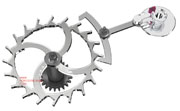
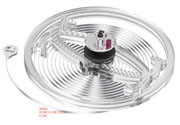
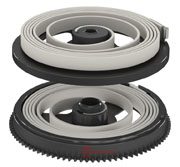
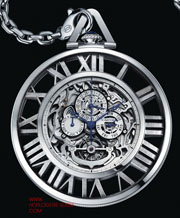

Tweet
On en parle sur le forum
La page de la marque